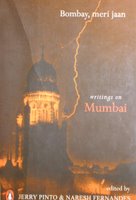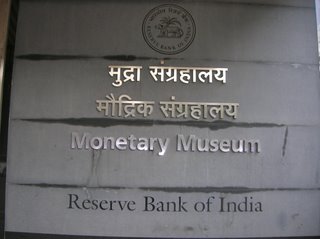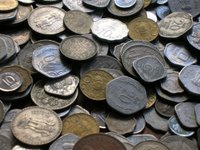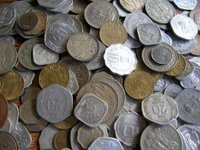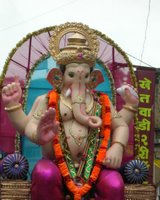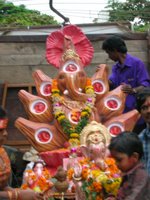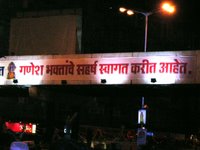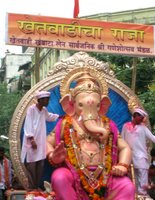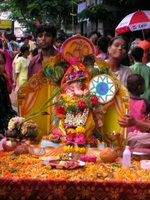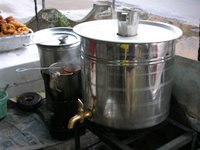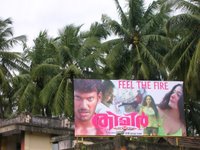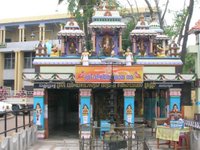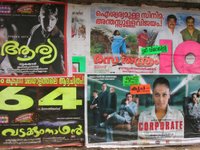A five-day theatre fest is currently going on (September 28-October 2, 2006) at the Mumbai Marathi Sahit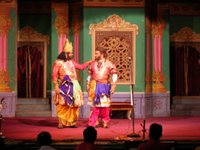 ya Sangh at Girgaum, near Charni Road station. This festival organized jointly with the Saraswat Co-operative Bank in memory of the late Dr Shrirang Adarkar, a theatre enthusiast and an ex-director with the Saraswat Bank.
ya Sangh at Girgaum, near Charni Road station. This festival organized jointly with the Saraswat Co-operative Bank in memory of the late Dr Shrirang Adarkar, a theatre enthusiast and an ex-director with the Saraswat Bank.
The festival has quite a mélange of plays in Marathi, Malvani, Hindi and English. The first one called Bin Baykacha Tamasha, as the name suggests has no women but men dressed as women. It was wonderful to see the men dancing in the tamasha form and the male singers who were singing in both male and female voices. Look at this link here and you will find it difficult to identify that the actors are all men.
Then there was Sangit Swayamwara, the Natya Sangeet form of theatre in which the plot was of Rukmini’s Swayamwara with Lord Krishna, Rukmini, Rukmini’s brother Rukmi, her father Bhishmaka, the King of Vidharba all part of the plot and were emoting out scenes through dialogues and moreover through classical singing. The photos that appear here are from this play. This form of theatre was made popular by the legendary Bal Gandharva.
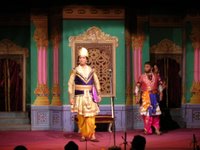
The other plays that are going to be staged are Magni Taso Puravtho, a play in Malvani by the famous comedian Macchindra Kambli, Katha Collage II directed by Naseeruddin Shah and Tamasha Mumbai Ishtyle, a comedy by Bharat Dabholkar.
Do pay a visit to this old theatre, which used to be an open air theatre in the 1920’s and for many years now is an enclosed auditorium named after Dr Bhalerao who was responsible for reviving Marathi drama in the 1940’s when the audience for plays had thinned out after people started turning towards films.
 ya Sangh at Girgaum, near Charni Road station. This festival organized jointly with the Saraswat Co-operative Bank in memory of the late Dr Shrirang Adarkar, a theatre enthusiast and an ex-director with the Saraswat Bank.
ya Sangh at Girgaum, near Charni Road station. This festival organized jointly with the Saraswat Co-operative Bank in memory of the late Dr Shrirang Adarkar, a theatre enthusiast and an ex-director with the Saraswat Bank.The festival has quite a mélange of plays in Marathi, Malvani, Hindi and English. The first one called Bin Baykacha Tamasha, as the name suggests has no women but men dressed as women. It was wonderful to see the men dancing in the tamasha form and the male singers who were singing in both male and female voices. Look at this link here and you will find it difficult to identify that the actors are all men.
Then there was Sangit Swayamwara, the Natya Sangeet form of theatre in which the plot was of Rukmini’s Swayamwara with Lord Krishna, Rukmini, Rukmini’s brother Rukmi, her father Bhishmaka, the King of Vidharba all part of the plot and were emoting out scenes through dialogues and moreover through classical singing. The photos that appear here are from this play. This form of theatre was made popular by the legendary Bal Gandharva.

The other plays that are going to be staged are Magni Taso Puravtho, a play in Malvani by the famous comedian Macchindra Kambli, Katha Collage II directed by Naseeruddin Shah and Tamasha Mumbai Ishtyle, a comedy by Bharat Dabholkar.
Do pay a visit to this old theatre, which used to be an open air theatre in the 1920’s and for many years now is an enclosed auditorium named after Dr Bhalerao who was responsible for reviving Marathi drama in the 1940’s when the audience for plays had thinned out after people started turning towards films.













